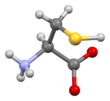
Back سيستئين Arabic سیستئین AZB Цыстэін BE Цыстэін BE-X-OLD Цистеин Bulgarian Cistein BS Cisteïna Catalan Cystein Czech Cystein Danish Cystein German
 Skeletal formula of L-cysteine
| |||
| |||
| Names | |||
|---|---|---|---|
| IUPAC name
Cysteine
| |||
Other names
| |||
| Identifiers | |||
3D model (JSmol)
|
|||
| Abbreviations | Cys, C | ||
| ChEBI | |||
| ChEMBL | |||
| ChemSpider | |||
| ECHA InfoCard | 100.000.145 | ||
| EC Number |
| ||
| E number | E920 (glazing agents, ...) | ||
| KEGG | |||
PubChem CID
|
|||
| UNII |
| ||
CompTox Dashboard (EPA)
|
|||
| |||
| |||
| Properties[4] | |||
| C3H7NO2S | |||
| Molar mass | 121.15 g·mol−1 | ||
| Appearance | white crystals or powder | ||
| Melting point | 240 °C (464 °F; 513 K) decomposes | ||
| 277g/L (at 25 °C)[1] | |||
| Solubility | 1.5g/100g ethanol 19 °C [2] | ||
| Acidity (pKa) | 1.71 (conjugate acid), 8.33 (thiol), 10.78[3] | ||
Chiral rotation ([α]D)
|
+9.4° (H2O, c = 1.3) | ||
| Supplementary data page | |||
| Cysteine (data page) | |||
Except where otherwise noted, data are given for materials in their standard state (at 25 °C [77 °F], 100 kPa).
| |||
Cysteine (symbol Cys or C;[5] /ˈsɪstɪiːn/)[6] is a semiessential[7] proteinogenic amino acid with the formula HOOC−CH(−NH2)−CH2−SH. The thiol side chain in cysteine enables the formation of disulfide bonds, and often participates in enzymatic reactions as a nucleophile. Cysteine is chiral, but both D and L-cysteine are found in nature. L‑Cysteine is a protein monomer in all biota, and D-cysteine acts as a signaling molecule in mammalian nervous systems.[8] Cysteine is named after its discovery in urine, which comes from the urinary bladder or cyst, from Greek κύστη kýsti, "bladder".[9]
The thiol is susceptible to oxidation to give the disulfide derivative cystine, which serves an important structural role in many proteins. In this case, the symbol Cyx is sometimes used.[10][11] The deprotonated form can generally be described by the symbol Cym as well.[11][12]
When used as a food additive, cysteine has the E number E920.
Cysteine is encoded by the codons UGU and UGC.
- ^ "PubChem data".
- ^ Belitz, H.-D; Grosch, Werner; Schieberle, Peter (2009-02-27). Food Chemistry. Springer. ISBN 9783540699330.
- ^ Kirste, Burkhard (23 Jan 1998). "Cysteine". Overview of Amino Acids. Free University of Berlin Dep't. of Biology, Chemistry, and Pharmacy. Archived 2016-11-10 at the Wayback Machine
- ^ Weast, Robert C., ed. (1981). CRC Handbook of Chemistry and Physics (62nd ed.). Boca Raton, Florida: CRC Press. p. C-259. ISBN 0-8493-0462-8..
- ^ "Nomenclature and symbolism for amino acids and peptides (IUPAC-IUB Recommendations 1983)". Pure and Applied Chemistry. 56 (5): 595–624. 1984. doi:10.1351/pac198456050595.
- ^ "cysteine - Definition of cysteine in English by Oxford Dictionaries". Oxford Dictionaries - English. Archived from the original on September 25, 2016. Retrieved 15 April 2018.
- ^ "The primary structure of proteins is the amino acid sequence". The Microbial World. University of Wisconsin-Madison Bacteriology Department. Archived from the original on 25 May 2013. Retrieved 16 September 2012.
- ^ Semenza, Evan R.; Harraz, Maged M.; Abramson, Efrat; Malla, Adarsha P.; Vasavda, Chirag; Gadalla, Moataz M.; Kornberg, Michael D.; Snyder, Solomon H.; Roychaudhuri, Robin (23 Sep 2021) [18 Aug 2021]. "D-cysteine is an endogenous regulator of neural progenitor cell dynamics in the mammalian brain". PNAS. 118 (39): e2110610118. Bibcode:2021PNAS..11810610S. doi:10.1073/pnas.2110610118. PMC 8488618. PMID 34556581.
- ^ Saffran, M. (April 1998). "Amino acid names and parlor games: from trivial names to a one-letter code, amino acid names have strained students' memories. Is a more rational nomenclature possible?". Biochemical Education. 26 (2): 116–118. doi:10.1016/s0307-4412(97)00167-2. ISSN 0307-4412.
- ^ "Amber Workshop - Tutorial A1 - Section 1: Do some editing of the PDB file". ambermd.org. Archived from the original on 2022-05-22. Retrieved 2022-06-02.
- ^ a b Lee, Jumin; Hitzenberger, Manuel; Rieger, Manuel; Kern, Nathan R.; Zacharias, Martin; Im, Wonpil (21 July 2020). "CHARMM-GUI supports the Amber force fields". The Journal of Chemical Physics. 153 (3): 035103. doi:10.1063/5.0012280. PMID 32716185. S2CID 220796795.
- ^ "Amber Workshop - Tutorial A1 - Section 1: Do some editing of the PDB file". ambermd.org. Archived from the original on 2022-05-22. Retrieved 2022-06-02.

